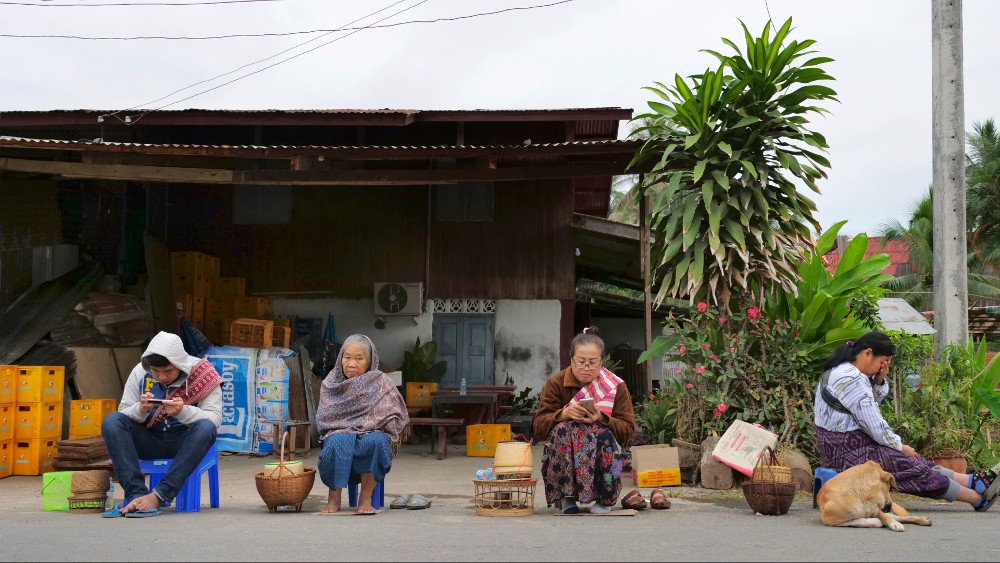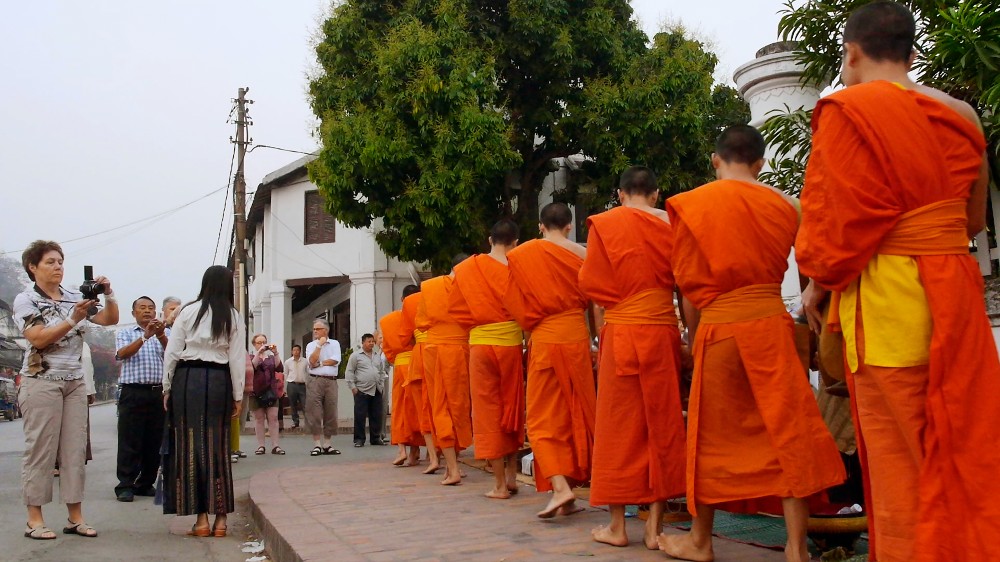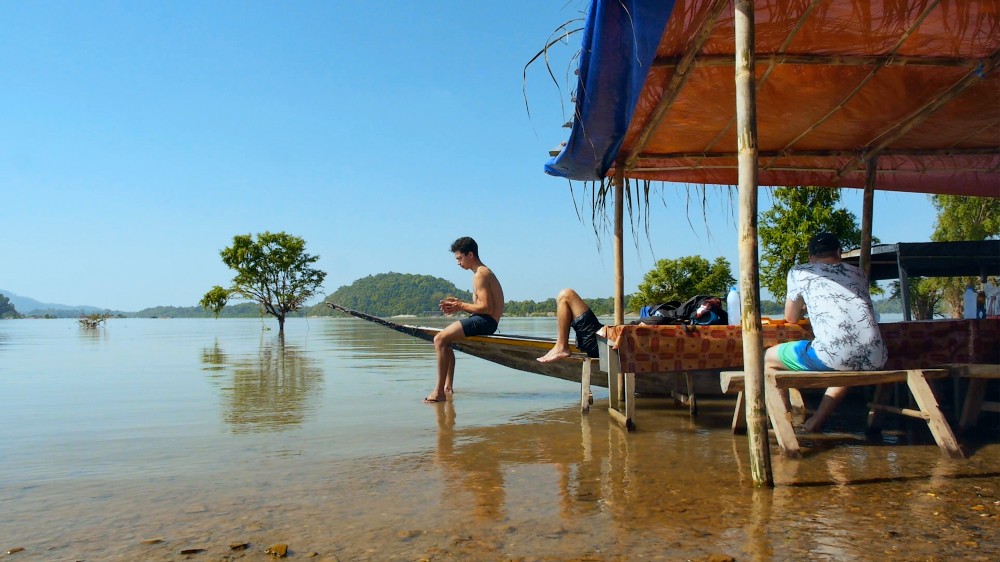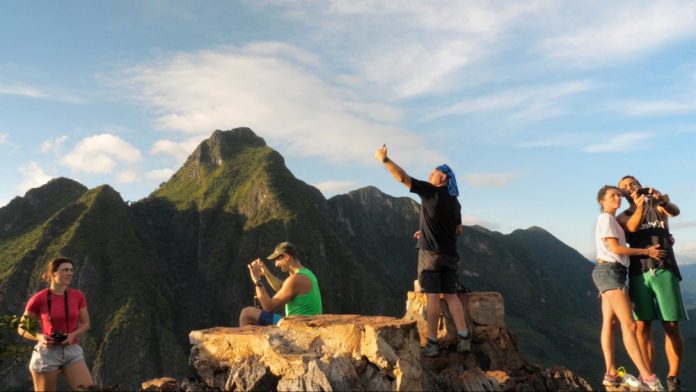Every once in awhile here at Above the Line, we’re going to break away from talking to the filmmakers behind the biggest studio releases of the week, and spend some time talking to indie filmmakers who are working just as hard for their craft in creating distinct and unique cinema that’s worth seeking out.
One great example of this is Kimi Takesue, a documentary filmmaker who has a unique aesthetic to filmmaking, which continues onto her latest film, Onlookers, which debuted at the Slamdance Film Festival in early 2023. Onlookers is a sensory travelogue to the country of Laos, though it’s one very much done in the cinema verité style of filmmaking, where Takesue’s camera captures events as they unfold with no direct narrative or narration explaining to the viewer what they’re watching, or for that matter, what they should feel. In that sense, Onlookers allows the viewer to create their own narrative.

The film features shot after gorgeous shot of the country, as locals and tourists alike wander in front of Takesue’s camera and do whatever they’re going to do. Takesue beautifully captures the mundane with shots of local merchants setting up their day-to-day routine, sightseers exploring the countryside, while contrasting the ever-present spirituality of the country with the commercialism of the tourist industry. In many ways, Onlookers is a relaxing and meditative experience that keeps you riveted with everything happening in Takesue’s frame during long stationary shots.
For the film, Takesue took on just about every role, from shooting as her own DP, capturing the sounds on location, then editing the film together herself over many years. Takesue has been making short films since 1995, but she also has three features under her belt: the 2010 doc Where Are You Taking Me?, which has a similar travel ethos as Onlookers, that one set in Uganda, and then the personal portrait of her grandfather for 2015’s 95 and 6 to Go.
Above the Line had an extended phone conversation with Takesue about not just Onlookers, but about her body of work, much of which will be available to watch via Metrograph’s At Home digital platform.
“A lot of my films have a body of work that does relate to cross-cultural travel,” she told us about how Onlookers fits in with her filmography, which mainly consists of documentary shorts. “A lot of that interest is connected to my background and my own upbringing, because I’m biracial – I’m half-Japanese-American and half white-American – and I grew up between Hawaii and Massachusetts, and I moved between these two very different cultural zones with my parents divorced. I really developed a sensibility of an outsider, who’s often on the margins looking in, but at the same time, [I was] able to assimilate and be a chameleon of sorts. It’s both this outsider position, but I find a lot of points and connections with new places and new cultures. That’s just been a theme that I’m drawn to, and I really do enjoy travel. I often pursue these pieces in a really exploratory way, where I’m just interested in going to the particular place.”

“In the context of Laos and Onlookers, it’s just a country that I had heard about,” she continued on her decision to visit the Southeast Asian country. “I was drawn to it initially in that I heard there was a very slow pace of life, and the Laotians are known for having a certain kind of tranquility, that the culture is just very patient and very slow. There is so much globalization going on within Southeast Asia, and so much change that’s happening to these cultures. It seemed like Laos was one culture that was a little bit slower, even in that rapid change happening throughout Southeast Asia. That was really the very simple prompt for that particular film.”
Making Onlookers involved two trips to Laos, each for roughly a month, as Takesue took a “standard tourist path and itinerary. “I’m only able to work with what I can carry,” she explains about her approach to the trip. “I’m traveling through this country on my own, so physically I can only handle so much in terms of the drives, the laptop, the camera, the tripod, because I’m bicycling somewhere with the tripod and the camera, it’s physically very strenuous. The locations are hot and challenging, physically, so I have a very modest setup, and I don’t want to draw any attention. I can easily be seen as a tourist. I certainly want, as much as possible, to be an unintimidating presence.”
“The first time I went, I started to collect footage, and I started to see what the strengths of it were,” she told us about her approach to start creating the film. “Part of the stylistic approach, in terms of the static long take, is also just dependent on the equipment. I’m using a JH5 Panasonic, and I don’t feel comfortable handholding that camera. I feel it works best for me if it is static. That is also dictating the aesthetics, to some degree, but then I start to see that what I particularly liked was this long take. When I went back the second time, it was with that in mind. ‘I do want to make this film, and I’m going to approach it in this way.’ Then, I have this footage, and a lot of times I sit on it for a period, and then go back to it, kind of rediscovering the material and making these loose associative connections. In this case, because it’s a journey, I do have the structure of place and a literal journey through a country. Otherwise, it’s very loose in terms of structure. Even that sense of meandering; it’s not just one direct line when you travel. That’s part of the pleasure, this kind of meandering quality to it.”

One thing that sets Onlookers aside and makes it so enjoyable to watch is how various scenes play out, sometimes seemingly by magic, as Takasue’s camera remains stationary on certain locations or temples and allows things to play out naturally. “I don’t usually wait for hours,” she says about her technique. “It’s a frame that I think is very interesting, and I just stay as long as I’m interested, because I don’t know if a shot will ever happen. So much of this is all about these serendipities cohering. There also are moments where you capture one element, but you don’t have all of them. There could be certain moments where the choreography is great, but the lighting is terrible, and then I can’t use it. Sometimes, you try to replicate it, and you might go back to a spot and see what happens. Occasionally, I might discover something or get something but maybe not. It’s like you never can completely recapture that one moment.”
“It really is just about being intensely present and in tune,” she elaborates. “My senses are so heightened when I’m making this kind of work – I’m just so alert to all the possibilities that are swirling around us. The reason I like travel is because I regain my ability to see anything and appreciate what’s actually happening around me that I ignore when I’m in New York or a place that’s familiar. That is what’s so exciting about the experience of travel, because it really is about this activation of my ability to see and hear and be present. What’s dictating everything is just how long do I actually want to be there and look at that situation and feel some kind of engagement with it. If it stops, then I just move on.”
“You’re thinking so differently about tactics and prioritization,” she says about her approach to cinematography. “In a film like Onlookers, the aesthetics and the composition are the foundation, and it really is this photographic piece and a particular stylization. This kind of static, formal form of cinematography can easily feel very cold and sterile, particularly when it’s applied to a lot of narrative work. It can be almost a little bit suffocating and just too aestheticized. What kind of works in Onlookers is you have a certain stylization, but it’s always being disrupted, and there’s this element of surprise by what’s naturally unfolding that is completely unpredictable. Obviously, the cinematography is so important in this form of stylization.”
Editing and post on Onlookers took many years, since Takesue cut the film on her own after going through all her footage in the months when she’s not teaching. She wasn’t quite sure how many hours of footage she ended up with after her two trips to Laos, but she elaborated on that part of the process. “The piece is edited over a number of years; it’s not a fast process for me, finding the rhythm and finding the structure, because I’m discovering it. I’m not going in with, ‘Oh, this is what this film is going to be, and this is how I envision it, and this is what the structure is going to be.’ I’m just discovering the material, and then trying to figure out the puzzle, how to put this together.”

Sound is another key aspect to the immersive experience of Onlookers, since it’s putting the viewer directly into this environment as Takesue was capturing it. “With sound in particular, I never quite know what I’m doing, but miraculously, the sound that I was able to capture it’s just incredible, because that’s all diegetic sound,” she told us. “The music in the film is all recorded there, so you have the music that’s being blasted to those speakers. You have the music from the karaoke at the wedding. You have the gongs, you have the drumming, all of these things. I’m really far from what I’m recording, and in some cases it’s the external mic. A couple of times, I was also doing some recording off of the Tascam, but it’s just kind of phenomenal that it ended up recording so well. The sound does play such an important part in the piece, and there is a lot of sound work done on this piece. There’s that naturalistic foundation, where I’m using all the sound that I recorded, but there are a lot of layers of additional sound, where I want it to still be naturalistic. I don’t want to go into the stylized really sound design-y realm, but there is amplification. I’m sure you notice the Foley, and there are definitely a lot of the detailed sounds that are heightened and amplified, just to give it another texture.”
“I think these films are so much about being transported and being taken elsewhere,” Takesue admits. “At the same time, I think they’re really emphasizing the idiosyncrasies of the human condition. Even though the film is maybe in a faraway place to a lot of viewers, it’s capturing these themes of universality of why do we travel? What is it that people are seeking? I am trying to represent the spectrum of human emotions in that journey, these moments of real exhilaration, moments of awkwardness, moments of fatigue, moments of intrusion and disruption, the whole spectrum of the human condition. And approaching it with humor, capturing the absurdity of life. There’s no didactic statement in this film. There are a lot of different entry points and ways to reflect upon the ideas of the film and the experiences and emotions, but also, the pleasure of being transported and the pleasure of beauty, and the pleasure of just image and sound.”
Takesue also understands how hard it is to get a film like Onlookers out into the world, having spent so many years making it, even holding it for a number of years after completion, so that it could be shown theatrically at Slamdance and other festivals, rather than just virtually. “When you are literally doing it by yourself, it’s not only the challenge of making it, but it’s getting it out into the world, because you’re competing with all of these productions that just have massive infrastructures and massive amounts of money and people to help amplify the film.”
Onlookers will play at the Metrograph in New York City, beginning Friday, Feb. 16, but then it will also be available via Metrograph At Home, beginning on Feb. 23 with other films by Ms. Takesue also available on the platform for just $5 a month.



